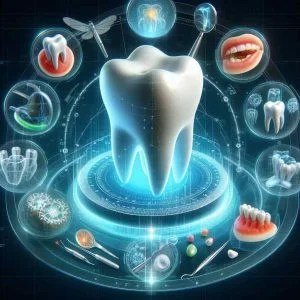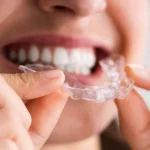Have you ever wondered why your teeth just can’t seem to stay straight, even with perfect brushing? You’re not alone.
With the rise in popularity of teeth straightening treatments like braces and aligners, it suggests a deeper cause beyond habits.
Could it be that our genes are playing a bigger role in our dental health than we realize?
In this guide, we’ll explore the role of genetics in causing crooked teeth or misalignment, and how it interacts with environmental factors.
We’ll also discuss the importance of early diagnosis and the various treatment options available.
We will thoroughly examine the current issue and address the prevailing confusion regarding the influence of genetics on the development of crooked teeth.
This exploration will encompass prominent search queries that underscore this confusion, including inquiries like, ‘Do my parents’ crooked teeth imply a likelihood of mine being crooked as well?’
Additionally, we will discuss the potential ramifications associated with overlooking the role of genetics in this context.
Remember, knowledge is power, and understanding the role of genetics in dental health can empower us to take control of our oral health and achieve that perfect smile!
A 2021 study by the National Institute of Dental and Craniofacial Research analyzed oral health and genetic data collected from over 500,000 participants and identified 47 areas of the genome linked to dental caries (tooth decay).
Problem: The Confusion Surrounding Genetics and Crooked Teeth

There’s a common question that many people ask when they look in the mirror:
“Do my parents’ crooked teeth mean mine will be crooked too?”
This question highlights widespread confusion about the role of genetics in dental health, particularly when it comes to crooked teeth or misalignment.
The internet is filled with conflicting information, making it difficult for people to understand the true impact of genetics on their dental health.
Some sources suggest that genetics play a significant role, while others downplay its importance, emphasizing environmental factors instead.
This confusion can lead to several potential problems.
For one, it can cause people to delay seeking treatment for their dental issues, under the mistaken belief that their problems are purely genetic and therefore unfixable.
This is far from the truth.
While genetics can influence the alignment of your teeth, it doesn’t mean that crooked teeth are inevitable or untreatable.
Moreover, this confusion can also lead to feelings of resignation. People may feel that they’re doomed to live with an unfixable smile because of their genes.
This can have a significant impact on their self-esteem and overall quality of life.
In the next section, we’ll delve into the science behind genetics and dental health, and shed light on the true relationship between the two. Stay tuned!
This 2019 study on How Genetic Factors Influence Human Dental discusses how genetic and environmental factors influence variation in the positioning of teeth within and between dental arches.
Solution: Unveiling the Truth About Genetics and Teeth Alignment

In this section, we promise to unveil the truth about genetics and its role in teeth alignment.
We’ll offer a comprehensive exploration of genetic factors, environmental influences, and their interplay.
Genetics and Teeth Alignment
Genetics play a significant role in many aspects of our health, including the alignment of our teeth.
Our genes determine the size of our jaw and our teeth, which can influence whether our teeth are crowded or spaced apart.
If you have a small jaw and large teeth, for example, you may be more likely to have crowded teeth.
On the other hand, if you have a large jaw and small teeth, you may be more likely to have gaps between your teeth.
However, genetics is not the only factor that determines the alignment of our teeth.
Environmental factors, such as thumb sucking, tongue thrusting, and prolonged use of a pacifier or bottle, can also influence teeth alignment.
The Interplay of Genetics and Environment
The alignment of our teeth is typically a result of both genetic and environmental factors.
While our genes may predispose us to certain dental issues, environmental factors can either exacerbate these issues or help mitigate them.
For example, even if you are genetically predisposed to having crowded teeth, practicing good oral hygiene and getting regular dental check-ups can help keep your teeth healthy and aligned.
Remember, understanding the complex interplay of genetics and environment in teeth alignment can empower us to take control of our oral health and achieve that perfect smile.
Always consult a dental professional for personalized advice and treatment options.
Genetics 101: Understanding the Basics

Genes are the basic units of heredity, passed down from parents to their offspring.
They are segments of DNA that carry the instructions for making proteins, the building blocks of our bodies. Each person has two copies of each gene, one inherited from each parent.
Now, let’s delve into how genes influence teeth and jaw development.
Genetic Factors Influencing Teeth and Jaw Development
Several key genetic factors can influence teeth and jaw development:
- Jaw Size: The size of your jaw is largely determined by your genes. A mismatch in jaw size and tooth size can lead to crowding or spacing of teeth.
- Tooth Size: Just like jaw size, the size of your teeth is also genetically determined. Large teeth in a small jaw can lead to crowding, while small teeth in a large jaw can lead to spacing.
- Number of Teeth: The number of teeth you have is also influenced by your genes. Some people may be genetically predisposed to have extra teeth (hyperdontia) or fewer teeth (hypodontia), both of which can affect alignment.
A 2021 study titled “Genetic Contribution to Malocclusion” supports these claims, highlighting the significant role of genetics in malocclusion, a condition characterized by misaligned teeth.
The Complex Nature of Genetics
It’s important to note that genetics is complex. Specific genes rarely dictate crooked teeth directly.
Instead, a combination of genes contributes to the overall size and shape of your jaw and teeth, which in turn can influence whether your teeth are straight or crooked.
In the next section, we’ll explore environmental factors that, along with genetics, contribute to teeth alignment. Stay tuned!
Beyond Genes: The Role of Environmental Factors

While genetics play a significant role in teeth alignment, they don’t tell the whole story.
How Environmental Factors Affect Misalignments
Environmental factors also have a substantial impact on the development and alignment of our teeth.
| Environmental Factors Affecting Misalignments | Description |
| Early Tooth Loss | Chronic mouth breathing can change the shape of the face and the alignment of the teeth. It can cause the development of a long, narrow face with flared nostrils, less defined cheekbones, drooping eyes, a narrow jaw, and a small or recessed chin, a condition often referred to as “long face syndrome. |
| Thumb Sucking | Prolonged thumb sucking, particularly beyond the age of 5 when permanent teeth start to come in, can cause the teeth to become pushed outwards, leading to an overbite or open bite. |
| Mouth Breathing | Chronic mouth breathing can change the shape of the face and the alignment of the teeth. It can cause the development of a long, narrow face with flared nostrils, less defined cheekbones, drooping eyes, a narrow jaw, and a small or recessed chin, a condition often referred to as “long face syndrome. |
| Diet | A diet lacking in essential nutrients can affect oral health and lead to dental problems that can impact teeth alignment. |
The 2019 study titled “Genetic and epigenetic aspects of class III malocclusion” emphasizes that the early concept of Class III malocclusion is thought to be governed heavily by genetic factors.
The Interplay of Genetics and Environment
The alignment of our teeth is typically a result of both genetic and environmental factors.
While our genes may predispose us to certain dental issues, environmental factors can either exacerbate these issues or help mitigate them.
For example, even if you are genetically predisposed to having crowded teeth, avoiding thumb sucking and maintaining good oral hygiene can help keep your teeth healthy and aligned.
Remember, understanding the complex interplay of genetics and environment in teeth alignment can empower us to take control of our oral health and achieve that perfect smile.
Always consult a dental professional for personalized advice and treatment options.
Diagnosis and Treatment: Hope Beyond Genetics

Even with a genetic predisposition, it’s important to remember that treatment options exist.
Dentists and orthodontists are equipped with the knowledge and tools to assess the cause of misalignment and provide appropriate treatment.
Assessment of Misalignment
Dentists and orthodontists use a variety of methods to determine the cause of misalignment.
This typically involves a thorough examination of the mouth, teeth, and jaw, and may also include X-rays or 3-D imaging to get a detailed view of the oral structures.
The professional will look at the size and position of the teeth and jaw, as well as any habits (like thumb sucking) or conditions (like mouth breathing) that could be contributing to the problem.
The Importance of Early Intervention
Early intervention is particularly important for children with genetic risk factors.
Recognizing and addressing these issues early can help guide the teeth into a more favorable position as they grow, potentially reducing the need for more extensive treatment later on.
Treatment Options
There are various treatment options available for correcting misalignment, including braces, aligners, and in some cases, jaw surgery.
The choice of treatment depends on the individual’s needs and the severity of the misalignment.
| Treatment Options for Misalignment | Description |
| Braces | Traditional braces work by applying continuous pressure over time to slowly move teeth in a specific direction. |
| Aligners | Clear aligners, like Invisalign, are a series of custom-made plastic trays that fit over your teeth. They’re less noticeable than traditional braces and can be removed for eating and cleaning. |
| Jaw Surgery | In severe cases, or when the misalignment is due to a skeletal issue, jaw surgery may be recommended. |
While genetics can play a role in teeth misalignment, it’s not the sole determinant. Environmental factors and personal habits also have a significant impact.
Understanding Your Smile
The alignment of our teeth is a complex interplay of both genetics and environmental factors. Genetics can influence the size and shape of our jaw and teeth, which in turn can affect alignment.
However, environmental factors such as early tooth loss, thumb sucking, mouth breathing, and diet also play a significant role.
Understanding your personal risk factors empowers you to seek early intervention and achieve a healthy, beautiful smile.
Even if you are genetically predisposed to having misaligned teeth, remember that various treatment options exist, from braces to aligners, and even jaw surgery in severe cases.
It’s important to consult with a dental professional for personalized advice and treatment options.
They can assess the cause of misalignment, guide you through the various treatment options, and help you decide on the best course of action.
If you are intrigued by the prospect of straightening your teeth and beautifying your smile with our FDA-certified invisible braces, we encourage you to take the next step.
Please fill out the form below, and our friendly customer service agents will reach out to guide you on the next steps. Rest assured, all your information will be kept private.
Remember, no matter your genetic makeup, a perfect smile is within your reach!








